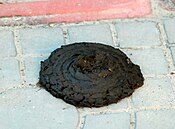
Back Ontlasting Afrikaans Kot ALS Tayi' AMI براز Arabic خرا ARY براز ARZ Jama Aymara Nəcis Azerbaijani Šūds BAT-SMG Udo BCL
Feces (also known as faeces or fæces; sg.: faex), are the solid or semi-solid remains of food that was not digested in the small intestine, and has been broken down by bacteria in the large intestine.[1][2] Feces contain a relatively small amount of metabolic waste products such as bacterially altered bilirubin, and dead epithelial cells from the lining of the gut.[1]
Feces are discharged through the anus or cloaca during defecation.
Feces can be used as fertilizer or soil conditioner in agriculture. They can also be burned as fuel or dried and used for construction. Some medicinal uses have been found. In the case of human feces, fecal transplants or fecal bacteriotherapy are in use. Urine and feces together are called excreta.

- ^ a b Tortora, Gerard J.; Anagnostakos, Nicholas P. (1987). Principles of anatomy and physiology (Fifth ed.). New York: Harper & Row, Publishers. p. 624. ISBN 978-0-06-350729-6.
- ^ Diem, K.; Lentner, C. (1970). "Faeces". in: Scientific Tables (Seventh ed.). Basle, Switzerland: CIBA-GEIGY Ltd. pp. 657–660.

